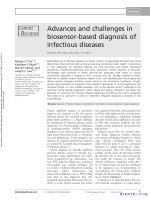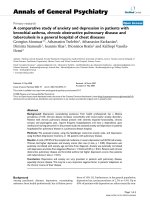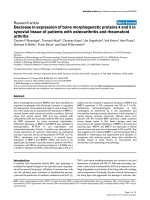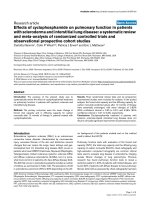ELEVATED CA 199 AND CEA IN CONNECTIVE TISSUE DISEASEASSOCIATED INTERSTITIAL LUNG DISEASE
Bạn đang xem bản rút gọn của tài liệu. Xem và tải ngay bản đầy đủ của tài liệu tại đây (4.7 MB, 28 trang )
ELEVATED CA 19-9 AND CEA IN
CONNECTIVE TISSUE DISEASEASSOCIATED INTERSTITIAL LUNG DISEASE
NGUYỄN THỊ HỒNG ANH, MD
CASE REPORT
DISCUSSION
Patient’s problems:
• 10 years of systemic scleroderma treatment
• Interstitial lung diseases
• Elevated serum CEA and CA 19-9 with no other
reasons for their elevation were detected (whole
body CT, digestive endoscopy).
• Cardio-vascular disease with high LDL-cholesterol
• Thyroid nodule TIRADS-2
• Interstitial lung diseases(ILDs) are a diverse group of lung diseases
that affect the lung parenchyma. They are characterized by an initial
inflammation of pulmonary alveoli that extends to the interstitium
and then leading to diffuse pulmonary fibrosis. ILDs are classified by
their etiology (known or unknown causes), and radiologicalpathological features. Connective tissue disease-associated ILD
(CTD-ILD) is ILD occurring due to CTD. In CTD, rheumatoid arthritis
(RA), systemic lupus erythematous (SLE), Sjögren’s syndrome (SS),
polymyositis/ dermatomyositis (PM/DM), systemic sclerosis (SSc),
and mixed connective tissue disease (MCTD) are susceptible to
respiratory involvement.(1)
•
•
Interstitial lung diseases are common in CTDs and they are the leading cause of
significant morbidity and mortality.(2) Clinically, acute exacerbation of ILD in CTDILD patients leads to respiratory failure and shortens survival. Due to the absence
of any significant prognostic biomarker, histopathological form of ILD is often used
as a prognostic predictor for CTD-ILD. However, histopathological diagnosis is
usually unavailable.(3) Thus, it is important to find out other markers available to
predict prognosis of ILD. Regarding the disease severity of ILD, involvement score
on high resolution computed tomography (HRCT,4) oxygenation index (OI) and
pulmonary function are usually used as evaluation tools. Nevertheless,
corresponding examinations of these tools are not suitable for severe patients.
Therefore, it is necessary to develop other markers to evaluate disease severity,
which will be useful information for individually-based treatment and posttreatment follow-up.
In our clinical work, we found that some CTD-ILD patients with advanced stage
had obviously increased serum carcinoembryonic antigen (CEA) and carbohydrate
antigen 19-9 (CA 19-9) levels while no other reasons for their elevation were
detected. CEA and CA 19-9 are both biomarkers of malignant tumors. CEA is a
complex glycoprotein. Elevated serum CEA is usually found in cancers of digestive
system and respiratory system, as well as in non- malignant conditions such as
ulcerative colitis, pancreatitis, cirrhosis and ascites.(5) CA 19-9 is a kind of
carbohydrate antigen. It is useful as a marker for cancers of digestive system and
other non-malignant diseases such as cholecystitis, cholangiolitis and
pancreatitis.(6) Previous studies reported that serum CEA and CA 19-9 levels are
also elevated in CTD and idiopathic pulmonary fibrosis (IPF).(7-9) So, we
speculated that elevation of serum CEA and CA 19-9 in CTD-ILD was related with
the pathogenetic condition of CTD-ILD itself.
•
•
The study included 82 CTD-ILD patients (54 males, 28 females; mean age 67.9 years; range
29 to 91 years) and 82 controls (54 males, 28 females; mean age 68.1 years; range, 30 to
92 years). The CTD-ILD patients were collected from the Respiratory Department of Tongde
Hospital of Zhejiang Province at the time of their first treatment in this hospital between
August 2007 and July 2015. CTD-ILD patients met the following inclusion criteria: (i)
Definite diagnosis: ILD was diagnosed according to the American Thoracic
Society/European Respiratory Society consensus classification.(10) ILD patients who met
the American College of Rheumatology criteria for CTD were defined as CTD-ILD
patients.(11-16) (ii) Without a history of malignancy or benign conditions associated with
increased CEA and CA 19-9, such as pancreatitis, cholecystitis, and ulcerative colitis. (iii)
Without environmental exposures and other known causes of ILD. (iv) Without pulmonary
edema, pulmonary infection, pulmonary embolism and other conditions that could affect
the pulmonary function and OI at the time of data being collected, but the existence of
pulmonary hypertension was allowed. CTD-ILD patients contained 35 RA patients, 16 SS
patients, seven PM/DM patients, seven SSc patients, four SLE patients, and 11 MCTD
patients. The control subjects without ILD or CTD were collected from the medical
examination center of the same hospital. They were matched with CTD- ILD patients with
respect to race, sex, height (within 4 cm), body weight (within 5 kg), smoking status, age
(within five years) and other diseases they were diagnosed with.
For CTD-ILD patients, disease severity was judged by pulmonary function, involvement
score on HRCT and OI. Detection of serum CA 19-9 and CEA levels, arterial blood gas
analysis, thoracic HRCT and pulmonary function were all finished in the first day of
inclusion into this study. All CTD-ILD patients were designed to follow- up for 12 months.
Follow-up was performed every month. Death caused by CTD-ILD was defined as the end
point. Data of controls were obtained from their health examination records. The study
protocol was approved by the Ethics Committee of Tongde Hospital of Zhejiang Province.
Written informed consent was obtained from all participants. The study was conducted in
accordance with the principles of the Declaration of Helsinki.
•
•
•
•
Blood specimens were obtained by a standard procedure between 06:00 and
07:00 in the morning. Detection procedures were conducted in two hours after
blood specimens were obtained. Serum CEA and CA 19-9 levels were analyzed by
microparticle enzyme immunoassays using Abbott reagent sets (AxSYM, Abbott
Laboratories, Chicago, IL, USA).
Pulmonary function, including percentage predicted diffusing capacity of the lung
for carbon monoxide (DLco %) and percentage predicted forced vital capacity (FVC
%), were measured by the Masterscreen PFT (Viasys/Jaeger; Höchberg, Germany).
Fraction of inspired oxygen (FiO2) was gained from the parameter of ventilation, or
calculated from the flow rate of inspired oxygen. Partial pressure of oxygen PaO2
(mmHg) was obtained from arterial blood gas analysis. OI was calculated as
OI=PaO2/FiO2.
Thoracic HRCT scans were evaluated by three observers who were blinded to all
the results above. The entire lung was scored on a scale of 0-5 for both alveolar
and interstitial abnormality. Ground-glass score represented the extent of alveolar
abnormality: 0: no ground- glass opacity (GGO); 1: GGO involving ≤5% (minimal,
but not normal); 2: involving 6%-24%; 3: involving 25%-49%; 4: involving 50%-75%;
5: involving >75%. Fibrosis score represented the extent of interstitial abnormality:
0: no fibrosis; 1: interlobular septal thickening; no discrete honeycombing; 2:
honeycombing (with or without septal thickening) involving <25%; 3: involving
25%-49%; 4: involving 50%-75%; 5: involving >75%. Final involvement percentage
was acquired from the average of three observers.
Results
•
•
Two CTD-ILD patients were excluded because of the occurrence of malignancy. Accordingly, data
were analyzed for a total of 80 patients and 80 controls. In addition, two patients suffered from
severe respiratory failure, so pulmonary function test was unavailable for them. For pulmonary
function related statistical analysis, these two patients and their controls were excluded. Within the
follow-up period of 12 months, none of the patients was lost to follow-up. But one patient died of
renal failure at 2.5 months and one died of cerebrovascular accident at 7.7 months. Related data
were considered as censored data. Sixteen patients (20%) died of CTD-ILD with a median survival
time of 5.785 months (range 2.17-11.2 months).
Power analyses were performed post hoc as per the method described by Dupont and
Plummer(17) In the analysis of serum CEA and CA 19-9 levels compared with controls, the power of
CEA was 99.9% and that of CA 19-9 was 88.2%. The power of FVC % and DLco % were both 99.9%.
The powers of correlation analysis ranged from 81.6% to 100%. In survival analysis, hazard ratio of
the low CEA level group relative to high CEA level group was 0.502, and finally the power was
81.7%. We calculated the hazard ratio of the low CA 19-9 level group relative to high CA 19-9 level
group of 0.487, and the power value was 84.9%. In univariate Cox regression analysis of CEA and CA
19-9 levels as prognostic factors for cumulative survival in CTD-ILD patients, the powers were
89.3% and 75.6%, respectively.
•
In this study, we demonstrated elevated serum CEA and CA 19-9 levels in CTD-ILD
patients. In previous studies, elevation of serum CEA and CA 19-9 was also found
in CTD.(8,18) In RA patients, CEA can be extracted from rheumatoid synovial
membranes.(7) Whether lesions of CTD on other sites of body can express CEA and
CA 19-9 is still unknown. Fortunately, recent studies showed that pulmonary tissue
could release CEA in IPF. In a study of bronchoalveolar lavage fluid and serum
measurement of CEA in 26 patients with histologically confirmed IPF, the
CEA/albumin ratio of bronchoalveolar lavage fluid was significantly higher than
that of serum, suggesting that CEA in bronchoalveolar lavage fluid is derived from
pulmonary tissue.(19) In another study, a lung biopsy specimen from a patient
with IPF demonstrated strong staining for CEA in metaplastic epithelium lining the
honeycombed cysts and respiratory bronchioles.(9) In our study, fibrosis score on
HRCT had obvious correlations with serum CEA and CA 19-9 levels, while groundglass score on HRCT had very weak correlations. These findings indicate that
pulmonary fibrosis tissue but not GGO of lung may be the origin of CEA. In patients
with pulmonary fibrosis, there is evidence of an increased incidence of lung
cancer;(20-22) however, this does not mean that elevated tumor markers standard
for malignant change. Furthermore, there are mechanistic and biological
similarities between pulmonary fibrosis and malignant disorders.(23) During the
process of pulmonary fibrosis, epithelial cells undergo a series of changes:
morphological changes of epithelial cells;(24) cytoskeletal changes; expression
changes of adhesion molecules; and formation of abnormal phenotypes of
epithelial cell between type II and type I cells. Finally, abnormal epithelial
proliferation and metaplastic change are formed.(25) In severe pulmonary
fibrosis, cuboidal pneumocytes are the predominant source of epithelial renewal,
and these cells are the most likely source of tumor markers release.(9,26)
Nonetheless, exact mechanism of these changes and tumor markers release and
elevation are still unknown and requiring further studies
•
•
Our results suggest that serum CEA and CA 19-9 levels are related with disease
severity of CTD-ILD. This is in accordance with previous research on IPF. In Fahim’s
study,(9) totally 41 IPF patients were included and final research results suggested
a correlation between serum CEA and pulmonary physiological derangement and
fibrosis scores. Traditionally, severity of ILD was measured by involvement score
on HRCT, OI and pulmonary function.(27) However, pulmonary function and
HRCT examinations are unsuitable for severe patients. OI can be influenced by
lung infection, heart failure and other factors. In these conditions, serum CEA and
CA 19-9 levels can be used as available markers to evaluate disease severity of
CTD-ILD.
In recent years, survival in ILD has been improved because of the proper use of
medications.(28,29) It is also demonstrated that the presence of CTD modifies
survival in patients with pulmonary fibrosis.(30) Nevertheless, it is still difficult to
evaluate the prognosis of CTD-ILD. In survival analysis, we found that cases with
high serum levels of CA 19-9 and CEA had significantly poorer prognosis. In
multivariate Cox regression analysis, serum CEA was finally demonstrated as the
only parameter that was obviously associated with one-year survival of CTD-ILD
cases. In fact, previous research also demonstrated the prognostic role of serum
CEA in RA patients and its correlation with other prognostic factors such as serum
rheumatoid factor levels.(17) For serum CA 19-9, a larger cohort is needed to
observe its significance as a prognostic factor. In our study, we provided one-year
survival analysis due to the high rate of loss to follow-up in the second year of
research, while five-year survival is much more significant for prognosis evaluation.
On the whole, serum CEA can be a cost-effective and convenient predictor for
short-term survival of CTD-ILD. To our knowledge, this is the first demonstration of
serum CEA as a prognostic factor for CTD-ILD patients.
• Our study has some limitations. First, we were unable to
clarify the cause for the elevation of serum CA 19-9 and
CEA in CTD-ILD patients and whether it was caused by CTD,
ILD or the interaction between CTD and ILD? Second, in
order to evaluate the effect of interaction between CTD
and ILD on the elevated levels of serum CEA and CA 19-9,
we should carry out a clinical study to compare serum CEA
and CA 19-9 levels among CTD-ILD patients, ILD patients
without CTD, and CTD patients without ILD. These issues
may constitute a base for future researches on related
mechanisms.
• In conclusion, our results suggest that serum CEA and CA
19-9 levels are elevated in CTD-ILD patients, and they
correlate with disease severity. Furthermore, we
demonstrated that serum CEA is a significant and
independent predictor of one- year survival of CTD-ILD
patients. For further research, we need a larger cohort and
follow- up for at least five years. If available, successive
detections of serum CEA and CA 19-9 are favorable to
evaluate their correlations with CTD- ILD progression.
•
Idiopathic pulmonary fibrosis presents a progressive and heterogeneous functional decline. CA 19-9
has been proposed as biomarker to predict disease course, but its role remains unclear. We assessed
CA 19-9 levels and clinical data in end-stage ILD patients (48 IPF and 20 non-IPF ILD) evaluated for
lung transplant, to correlate these levels with functional decline. Patients were categorized based on
their rate of functional decline as slow (n = 20; ΔFVC%pred ≤ 10%/year) or rapid progressors (n = 28;
ΔFVC%pred ≥ 10%/year). Nearly half of the entire patients (n = 32; 47%) had CA 19-9 levels ≥37kU/L.
CA 19-9 levels in IPF were not different from non-IPF ILD populations, however, the latter group had a
median CA 19-9 level above the normal cut-off value of 37 KU/l (60 [17–247] kU/L). Among IPF
patients, CA 19-9 was higher in slow than in rapid progressors with a trend toward significance
(33vs17kU/L; p = 0.055). In the whole population, CA19-9 levels were inversely related with
ΔFVC/year (r = −0.261; p = 0.03), this correla on remained in IPF pa ents, par cularly in rapid
progressors (r = −0.51; p = 0.005), but not in non. Moreover, IPF rapid progressors with normal CA 199 levels showed the greater ΔFVC/year compared to those with abnormal CA 19-9 (0.95 vs. 0.65
L/year; p = 0.03). In patients with end-stage ILD, CA 19-9 may represent a marker of disease
severity, whereas its level is inversely correlated with functional decline, particularly among IPF
rapid progressors.
-
-
High serum levels of the Klebs von den Lungen-6 (KL-6) have been found in
patients with various respiratory diseases, including ILD types of idiopathic
interstitial pneumonia, collagen vascular disease-associated interstitial
pneumonia, hypersensitivity pneumonia, sarcoidosis, lung cancer, and
tuberculosis.
Serum levels of the Klebs von den Lungen-6 (KL-6) were elevated in ILD
patients with severe respiratory function compared to those without. The
rate of poor prognosis and mortality was associated with increased
biomarker concentrations. Sequential measurements of biomarkers could
be valuable in disease monitoring and evaluations in clinical management.









